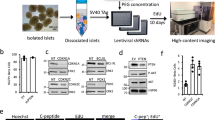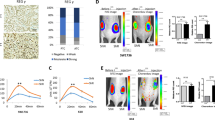Abstract
The growth factor receptor-bound protein (Grb) 14 is an adaptor molecule of the Grb7/10/14 family with characteristic Between Plekstrin and SH2 (BPS) domains serving to avidly bind tyrosine kinases. Grb14 inhibits insulin receptor (IR) catalytic activity through interaction with the BPS domain and impedes peptide substrate binding. Members of this Grb family have also been shown to interact with other kinases through their SH2 domain. Here we examined the functional role of Grb14 in thyroid cancer using loss- and gain-of-function approaches. Stable knockdown of Grb14 in thyroid cancer cells facilitated IR signaling. In contrast, RET phosphorylation was diminished in concert with reduced activation of Akt and signal transducer and activator of transcription 3 (STAT3). Loss of Grb14 also resulted in diminished cell proliferation and invasion both in vitro and in mouse flank xenografts. In complementary studies, forced expression of Grb14 interrupted IR signaling but facilitated RET activation, STAT3 and Akt phosphorylation. Consistent with these findings Grb14 overexpression enhanced cell invasion and resulted in striking metastases in an orthotopic thyroid cancer mouse xenograft model. Primary human thyroid cancer microarrays revealed a positive correlation between Grb14 expression and invasive behavior. Our findings uncover a new role for Grb14 in finely tuning receptor signaling and modulating thyroid cancer progression.
This is a preview of subscription content, access via your institution
Access options
Subscribe to this journal
Receive 50 print issues and online access
$259.00 per year
only $5.18 per issue
Buy this article
- Purchase on Springer Link
- Instant access to full article PDF
Prices may be subject to local taxes which are calculated during checkout






Similar content being viewed by others
References
Asa SL . (2001). How familial cancer genes and environmentally induced oncogenes have changed the endocrine landscape. Mod Pathol 14: 246–253.
Avantaggiato V, Dathan NA, Grieco M, Fabien N, Lazzaro D, Fusco A et al. (1994). Developmental expression of the RET protooncogene. Cell Growth Differ 5: 305–311.
Bai T, Luoh SW . (2008). GRB-7 facilitates HER-2/Neu-mediated signal transduction and tumor formation. Carcinogenesis 29: 473–479.
Bereziat V, Kasus-Jacobi A, Perdereau D, Cariou B, Girard J, Burnol AF . (2002). Inhibition of insulin receptor catalytic activity by the molecular adapter Grb14. J Biol Chem 277: 4845–4852.
Briese J, Ezzat S, Liu W, Winer D, Wagener C, Bamberger AM et al. (2010). Osteopontin expression in thyroid carcinoma. Anticancer Res 30: 111–122.
Buckwalter TL, Venkateswaran A, Lavender M, La Perle KM, Cho JY, Robinson ML et al. (2002). The roles of phosphotyrosines-294, -404, and -451 in RET/PTC1-induced thyroid tumor formation. Oncogene 21: 8166–8172.
Cheng S, Liu W, Mercado M, Ezzat S, Asa SL . (2009). Expression of the melanoma-associated antigen is associated with progression of human thyroid cancer. Endocr Relat Cancer 16: 455–466.
Cheng S, Serra S, Mercado M, Ezzat S, Asa SL . (2011). A high-throughput proteomic approach provides distinct signatures for thyroid cancer behavior. Clin Cancer Res 17: 2385–2394.
Cooney GJ, Lyons RJ, Crew AJ, Jensen TE, Molero JC, Mitchell CJ et al. (2004). Improved glucose homeostasis and enhanced insulin signalling in Grb14-deficient mice. EMBO J 23: 582–593.
Daly RJ, Sanderson GM, Janes PW, Sutherland RL . (1996). Cloning and characterization of GRB14, a novel member of the GRB7 gene family. J Biol Chem 271: 12502–12510.
de Groot JW, Links TP, Plukker JT, Lips CJ, Hofstra RM . (2006). RET as a diagnostic and therapeutic target in sporadic and hereditary endocrine tumors. Endocr Rev 27: 535–560.
Durbec P, Marcos-Gutierrez CV, Kilkenny C, Grigoriou M, Wartiowaara K, Suvanto P et al. (1996). GDNF signalling through the RET receptor tyrosine kinase. Nature 381: 789–793.
Engelmann D, Koczan D, Ricken P, Rimpler U, Pahnke J, Li Z et al. (2009). Transcriptome analysis in mouse tumors induced by Ret-MEN2/FMTC mutations reveals subtype-specific role in survival and interference with immune surveillance. Endocr Relat Cancer 16: 211–224.
Ezzat S, Mader R, Yu S, Ning T, Poussier P, Asa SL . (2005). Ikaros integrates endocrine and immune system development. J Clin Invest 115: 1021–1029.
Ezzat S, Zheng L, Zhu XF, Wu GE, Asa SL . (2002). Targeted expression of a human pituitary tumor-derived isoform of FGF receptor-4 recapitulates pituitary tumorigenesis. J Clin Invest 109: 69–78.
Han DC, Shen TL, Guan JL . (2001). The Grb7 family proteins: structure, interactions with other signaling molecules and potential cellular functions. Oncogene 20: 6315–6321.
Hwang JH, Kim DW, Suh JM, Kim H, Song JH, Hwang ES et al. (2003). Activation of signal transducer and activator of transcription 3 by oncogenic RET/PTC (rearranged in transformation/papillary thyroid carcinoma) tyrosine kinase: roles in specific gene regulation and cellular transformation. Mol Endocrinol 17: 1155–1166.
Kasus-Jacobi A, Perdereau D, Auzan C, Clauser E, Van Obberghen E, Mauvais-Jarvis F et al. (1998). Identification of the rat adapter Grb14 as an inhibitor of insulin actions. J Biol Chem 273: 26026–26035.
Kondo T, Ezzat S, Asa SL . (2006). Pathogenetic mechanisms in thyroid follicular-cell neoplasia. Nat Rev Cancer 6: 292–306.
Liu W, Wei W, Winer D, Bamberger AM, Bamberger C, Wagener C et al. (2007). CEACAM1 impedes thyroid cancer growth but promotes invasiveness: a putative mechanism for early metastases. Oncogene 26: 2747–2758.
Marchini S, Mariani P, Chiorino G, Marrazzo E, Bonomi R, Fruscio R et al. (2008). Analysis of gene expression in early-stage ovarian cancer. Clin Cancer Res 14: 7850–7860.
Margolis B . (1994). The GRB family of SH2 domain proteins. Prog Biophys Mol Biol 62: 223–244.
Nouaille S, Blanquart C, Zilberfarb V, Boute N, Perdereau D, Roix J et al. (2006). Interaction with Grb14 results in site-specific regulation of tyrosine phosphorylation of the insulin receptor. EMBO Rep 7: 512–518.
Pandey A, Duan H, Di Fiore PP, Dixit VM . (1995). The Ret receptor protein tyrosine kinase associates with the SH2-containing adapter protein Grb10. J Biol Chem 270: 21461–21463.
Pandey A, Liu X, Dixon JE, Di Fiore PP, Dixit VM . (1996). Direct association between the Ret receptor tyrosine kinase and the Src homology 2-containing adapter protein Grb7. J Biol Chem 271: 10607–10610.
Reilly JF, Mickey G, Maher PA . (2000). Association of fibroblast growth factor receptor 1 with the adaptor protein Grb14. Characterization of a new receptor binding partner. J Biol Chem 275: 7771–7778.
Saji M, Ringel MD . (2010). The PI3K-Akt-mTOR pathway in initiation and progression of thyroid tumors. Mol Cell Endocrinol 321: 20–28.
Sullivan I, Chopra A, Carr J, Kim TS, Cohen EP . (2008). Immunity to growth factor receptor-bound protein 10, a signal transduction molecule, inhibits the growth of breast cancer in mice. Cancer Res 68: 2463–2470.
Wang Y, Chan DW, Liu VW, Chiu P, Ngan HY . (2010). Differential functions of growth factor receptor-bound protein 7 (GRB7) and its variant GRB7v in ovarian carcinogenesis. Clin Cancer Res 16: 2529–2539.
Yu H, Pardoll D, Jove R . (2009). STATs in cancer inflammation and immunity: a leading role for STAT3. Nat Rev Cancer 9: 798–809.
Acknowledgements
We thank Kelvin So for his technical assistance. This work was supported by the Canadian Institutes of Health Research (CIHR)(Grant MOP-86493), the Princess Margaret Hospital Foundation and the Ontario Ministry of Health and Long Term Care (OMOHLTC).
Author information
Authors and Affiliations
Corresponding author
Ethics declarations
Competing interests
The views expressed do not necessarily reflect those of the OMOHLTC.
Additional information
Supplementary Information accompanies the paper on the Oncogene website
Rights and permissions
About this article
Cite this article
Balogh, K., Asa, S., Zheng, L. et al. The insulin resistance Grb14 adaptor protein promotes thyroid cancer ret signaling and progression. Oncogene 31, 4012–4021 (2012). https://doi.org/10.1038/onc.2011.569
Received:
Revised:
Accepted:
Published:
Issue Date:
DOI: https://doi.org/10.1038/onc.2011.569
Keywords
This article is cited by
-
GRB10 is a novel oncogene associated with cell proliferation and prognosis in glioma
Cancer Cell International (2022)
-
High expression of growth factor receptor-bound protein 14 predicts poor prognosis for colorectal cancer patients
Biotechnology Letters (2016)
-
An epigenetic map of age-associated autosomal loci in northern European families at high risk for the metabolic syndrome
Clinical Epigenetics (2015)
-
Selective repression of RET proto-oncogene in medullary thyroid carcinoma by a natural alkaloid berberine
BMC Cancer (2015)



